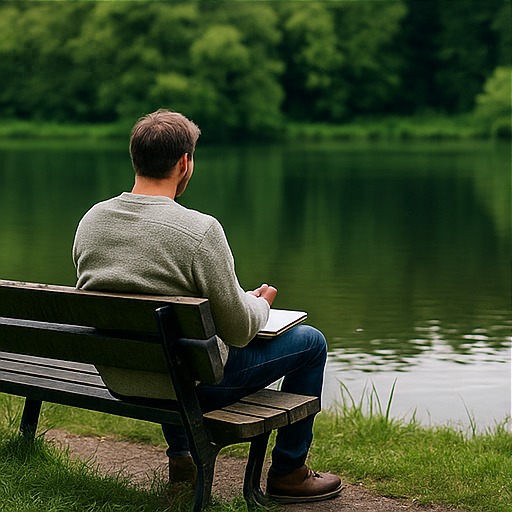Step outside and the pace changes. Air moves differently, sounds arrive from farther away, and thoughts loosen their grip. Nature offers a counterweight to modern life - one that restores attention, steadies mood, and reconnects us to the physical world. You don’t need a national park pass; a tree-lined street, a riverbank path, or a small city park can be enough.
Time outdoors is not an escape so much as a recalibration. Even short encounters with green space deliver benefits that stack across the day: clearer thinking, lighter stress, a more generous perspective. The goal isn’t to become a hiker overnight; it’s to weave small, consistent moments of nature into ordinary routines.
Below are eight ways time in nature strengthens body and mind, plus simple cues to make the habit stick. Treat this as a field guide for everyday life, not a checklist.
The most important step is the first one out the door. After that, nature tends to do the convincing on its own.

1. Lower stress and calmer nervous system
Green spaces quiet the nervous system. Heart rate and cortisol can settle after even brief walks among trees or water. The effect comes from a mix of factors: fresh air, gentle motion, and fewer artificial demands on attention.
Try to notice textures and sounds - leaves, wind, birds - to anchor the mind. This kind of soft focus interrupts the loop of worry and overthinking.
Short daily doses beat rare marathons. Ten minutes near trees or a riverside path can defuse accumulated tension from work and screens.
Think of nature as a pressure valve you can open on demand, not a once-a-year vacation.
When stress feels sticky, step outside before you try to push through it at your desk.
2. Better mood and steadier outlook
Light, color, and movement lift mood in ways indoor fixes rarely match. The simple act of walking under open sky nudges the brain toward balance.
Pair nature time with a gentle ritual - a morning loop around the block or a sunset walk - to make the lift predictable.
On hard days, lower the bar: step outside for five minutes, no goals beyond noticing what’s around you. Often that brief reset invites a longer stay.
If you can share the walk with a friend, the benefit multiplies. Conversation feels easier when you’re moving side by side.
Over weeks, these small outings add resilience that carries through tougher moments.


3. Sharper attention and mental clarity
Natural settings gently engage attention without exhausting it, a concept researchers call “soft fascination.” The result is clearer thinking after you return.
Use a short nature break before deep work. Five to fifteen minutes outside can be enough to reset focus and reduce the urge to multitask.
Leave your phone in a pocket or bag. Let your eyes travel farther than a screen; distance itself is a mental stretch.
If ideas are stuck, walking under trees often loosens them. Bring a small notebook to catch whatever shows up.
Clarity is a late reward - it arrives after a gentle dose of being unhurried.
4. Physical health: movement without punishment
Outdoor movement feels less like a chore. Soft surfaces are kinder to joints, varied terrain recruits stabilizers, and fresh air encourages you to stay out longer.
Start with easy loops and build gradually. A relaxed walk, a short bike ride, or a gentle jog all count - consistency matters more than speed.
If you already train indoors, add an outdoor session each week. Changing scenery reduces boredom and can improve adherence.
Sunlight helps set your body clock and supports vitamin D synthesis, especially in morning hours.
Think of the outdoors as a gym where membership is simply showing up.


5. Creativity and problem-solving
Ideas tend to surface when the mind is relaxed and mildly engaged - exactly the state nature encourages. Many people report that solutions arrive mid-walk, not mid-email.
Switch your next brainstorming session to a park bench or a slow loop around the block. Capture thoughts with a voice memo so you can keep moving.
Novelty matters. Vary your route or time of day to give the brain fresh inputs to work with.
Creative work often benefits from rhythm more than intensity; nature provides that rhythm automatically.
Protect these sessions like appointments. They look unproductive from the outside, then pay off later at the desk.
6. Connection and community
Parks and paths invite casual connection. A nod to a neighbor, a short chat with a dog owner, or joining a local walking group builds social fabric without scheduling meetings.
Family time outdoors tends to be easier and more relaxed. Kids explore, adults decompress, and everyone returns home with better energy.
Shared nature rituals - weekend hikes, evening strolls, sunrise coffees on a bench - create memories that outlast most screen time.
Loneliness often melts in places where people move together without pressure to perform.
Community found in nature is low-friction and high-reward.


7. Perspective and gratitude
Standing near water, looking at a skyline from a hill, or watching a storm roll in reframes problems. Perspective expands; urgency shrinks.
Practice a simple gratitude check on walks: name three things you see that you appreciate - a color, a sound, a pattern of light.
This small practice trains attention toward what’s stable and good, even when daily life is noisy.
Over time, gratitude becomes a reflex you can access indoors as well.
Nature doesn’t fix everything, but it reliably shifts the angle of view.
8. Make it a habit you keep
Set a minimum you can keep on busy days - five minutes counts. Most “short” outings stretch once you start.
Pair nature time with an anchor: after breakfast, during lunch, or right after work. Habits stick when they ride existing routines.
Prepare simple gear by the door: comfortable shoes, a light jacket, a small umbrella. Weather becomes less of a veto.
Track streaks if that motivates you, but let curiosity lead. Explore a new street, a different park, or a path you’ve never tried.
Ultimately, the point is to feel more human - present, spacious, and connected - a little each day.
